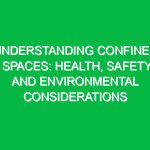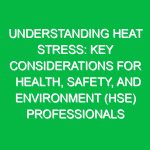In the realm of Health, Safety, and Environment (HSE), hazard signs serve as crucial visual indicators that communicate potential dangers in various environments. These signs are not mere decorations; they are essential tools that provide vital information to ensure safety in workplaces, public spaces, and beyond. Understanding hazard signs is paramount for HSE professionals tasked with safeguarding workers, the public, and the environment. This comprehensive guide delves into the types of hazard signs, their significance, associated risks, safety precautions, and the regulatory landscape surrounding them.
What Are Hazard Signs?
Hazard signs are graphic symbols or words used to convey information about potential hazards or unsafe conditions. They alert individuals to risks that could lead to accidents or injuries if not heeded. Positioned strategically in workplaces, construction sites, laboratories, and other environments, these signs help in fostering a culture of safety by promoting awareness.
Take, for instance, a construction site where heavy machinery is in operation. The presence of a “Caution: Heavy Equipment” sign warns workers and visitors alike about the potential risks of moving machinery, thus enabling them to exercise caution and make informed decisions. Such signs can be the difference between a safe working environment and a tragic accident.
The Importance of Hazard Signs in HSE
The role of hazard signs in HSE cannot be overstated. They serve multiple purposes:
- Prevention of Accidents: By clearly communicating risks, hazard signs help prevent accidents before they occur.
- Legal Compliance: Many regulations require the use of specific hazard signs, helping organizations comply with safety laws.
- Training Aid: Hazard signs can be used in training programs to educate employees about potential risks in their work environments.
As an HSE professional, understanding the nuances of these signs is essential. They are more than just images; they are a call to action for vigilance and safety.
Types of Hazard Signs and Their Meanings
Hazard signs can be broadly categorized into several types, each with its own distinct meaning:
1. Warning Signs
Warning signs are typically yellow and triangular, indicating a potential hazard or unsafe condition that requires caution. For example, a “Slippery When Wet” sign alerts individuals to exercise care in wet areas to avoid falls.
2. Caution Signs
Caution signs, often in yellow with a black border, denote a lower level of risk that may still cause injuries. An example would be “Caution: Low Headroom,” which warns individuals to be mindful of their surroundings.
3. Danger Signs
Danger signs are usually red and indicate an immediate hazard that can lead to severe injuries or fatalities. A “Danger: High Voltage” sign signals that electrical components pose a threat, necessitating immediate action to avoid contact.
4. Biohazard Signs
These signs, often featuring a distinctive symbol, alert individuals to the presence of biological hazards. For instance, a “Biohazard” sign in a laboratory indicates that materials handled may pose health risks, such as infectious agents.
5. Fire Safety Signs
Fire safety signs indicate the location of fire-fighting equipment and evacuation routes. A “Fire Extinguisher” sign not only guides individuals to safety equipment but also fosters an understanding of safety protocols in emergencies.
Identifying Hazards and Associated Risks
Each type of hazard sign corresponds to specific hazards that HSE professionals must identify and assess. Recognizing these hazards requires a keen understanding of the environment in which the signs are displayed. For example:
- Chemical Hazards: Signs indicating the presence of toxic substances can prevent exposure and related health issues.
- Physical Hazards: Signs warning of machinery, heights, or electrical risks highlight physical dangers that can lead to severe injuries.
- Environmental Hazards: Signs indicating potential environmental risks, such as “Danger: Asbestos,” are crucial for preventing contamination and health issues.
In my experience working on construction sites, I’ve witnessed the effectiveness of hazard signs firsthand. One day, a crew member ignored a “Caution: Falling Objects” sign, resulting in a near-miss incident when a tool fell from above. This incident reinforced the necessity of adhering to the messages conveyed by these signs.
Safety Precautions and Best Practices
To maximize the effectiveness of hazard signs, implementing safety precautions and best practices is essential. Here are some actionable strategies:
1. Regular Training
Conduct regular training sessions for employees about the meanings and importance of hazard signs. This not only raises awareness but also empowers individuals to take responsibility for their safety and that of their colleagues.
2. Sign Placement
Ensure that hazard signs are prominently placed in areas where hazards are present. They should be visible from a distance and free from obstructions. Routine inspections can help ascertain that signs remain in good condition and are correctly positioned.
3. Clear Communication
Use clear language and symbols on signs to avoid confusion. In multicultural environments, consider including multiple languages to ensure that all workers understand the risks.
4. Encourage Reporting
Establish a culture that encourages employees to report any damaged or missing hazard signs. A simple “See Something, Say Something” approach can significantly enhance safety.
5. Integrate Signage into Safety Procedures
Incorporate hazard signs into your company’s safety procedures and protocols. This integration ensures that workers understand the signs as part of their safety responsibilities.
Regulations and Standards Governing Hazard Signs
Several regulations and standards govern the use of hazard signs. Familiarity with these guidelines is crucial for HSE professionals:
- Occupational Safety and Health Administration (OSHA): OSHA outlines the requirements for hazard communication, including the proper use of signs in the workplace.
- International Organization for Standardization (ISO): ISO 7010 provides standardized safety signs that ensure consistency across different countries and industries.
- American National Standards Institute (ANSI): ANSI Z535 sets forth the standards for safety signage, focusing on design, color, and placement.
Compliance with these regulations not only enhances workplace safety but also protects organizations from legal repercussions. Understanding and adhering to these standards is a fundamental responsibility of HSE professionals.
Conclusion
Hazard signs are an integral component of health, safety, and environmental management. Through effective communication, training, and adherence to regulations, HSE professionals can foster a safer working environment. By understanding the different types of hazard signs, the associated risks, and best practices for safety, professionals can significantly mitigate workplace hazards. In the end, the objective remains clear: ensuring that every worker returns home safely, equipped with the knowledge and awareness to navigate their environment confidently.


